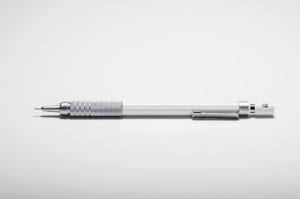Next time youre using a pen, glance down and observe its design.
Chances are youve never done this before. 
Observe the interplay between its form, function, and shape, the care that has gone into an object most of us use without thought daily.
The same could be said for any object lying around the home or officeand more often than not, you will have never bothered to inspect them. They just work or not.
When we started our careers, architects and technicians work white coats, with a thick, grey streak of lead shavings across their midriff from the constant sharpening of mechanical pencils long, plastic and steel clutch pencils that were an essential tool in draughting designs prior to committing pen to (tracing) paper. The pencils were a personalised companion of our profession, constantly needing adjustment via sharpening boxes uniformly bolted to desks. A fusion of product design and architecture.
Some of the best architects of the last century had dalliances in product designFrank Lloyd Wright and Mies van der Rohe were incredibly passionate about chair design. At the same time, Britains own Jony Ive, Chief Design Officer at Apple, began his career as an architectural designer. The overlap between the two has grown increasingly fluid, yet the design guidelines remain the samegreat design will always speak of practicality, simplicity and innate intuitiveness.
This concept can be seen in the dismantling of every single product we usejust like the pen you write with, the phone in your pocket and the chair you sit onthere is always a constant thread of purity and simplicity of manufacture in almost every piece.
As time passes, the transference of knowledge between architects, interior designers and product design will growwhich will only lead to even more daring design adventures.
So next time youre using your pen, consider its form, its aesthetics and function, and all of the decisions that passed in it coming off the production line. We may not use the mechanical pencil much these days, but the link between architecture, design and our everyday lives is as strong as ever.